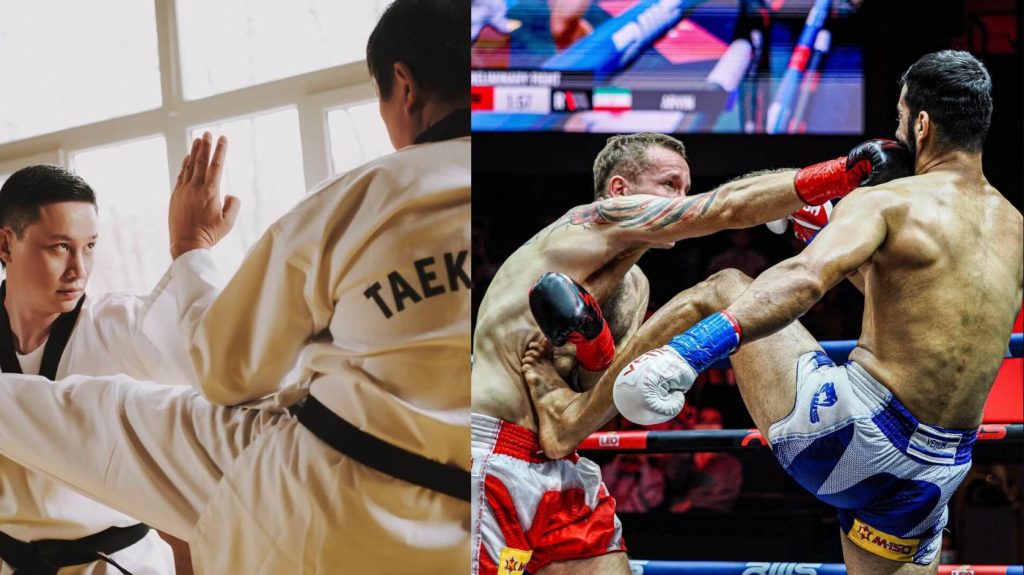When deciding between Muay Thai and Taekwondo, many people wonder: which martial art is better? The truth is, it depends on your goals. Both are powerful and respected combat systems with unique origins, techniques, and benefits. Whether you’re looking for self-defense, competition, fitness, or discipline, understanding how these two martial arts compare can help you make an informed decision.
Table of Contents
1. Origins and Philosophy
Both martial arts are deeply rooted in national identity and history, but they come from different cultural backgrounds and were developed for different purposes.
| Attribute | Muay Thai | Taekwondo |
|---|---|---|
| Country of Origin | Thailand | South Korea |
| Developed In | 13th–14th century (modernized in 20th century) | 1940s–1950s |
| Combat Focus | Striking with 8 limbs + clinch | Kicking-focused with some punches |
| Traditional Elements | Wai Kru dance, Buddhist influence | Dojang etiquette, Korean philosophy |
| Competitive Arena | Muay Thai rings (stadiums) | Olympic-style sparring |
2. Techniques and Fighting Styles
Muay Thai is known as the Art of Eight Limbs because it uses fists, elbows, knees, and shins. Taekwondo is more focused on dynamic kicks and agility, especially head-height and spinning kicks.
Technical Comparison
| Technique Type | Muay Thai | Taekwondo |
|---|---|---|
| Punches | Jab, Cross, Hook, Uppercut | Basic jab, reverse punch |
| Kicks | Roundhouse, Push Kick, Low Kick | Roundhouse, Axe Kick, Spinning Kick |
| Elbows | Yes – multiple angles (cutting weapon) | Rare (not allowed in sport competition) |
| Knees | Yes – straight, flying, clinch-based | Rare or none |
| Clinching | Very common (control + attack) | Not used |
| Footwork | Forward pressure, powerful stance | Light, bouncing, side-stepping |
3. Training Methods
While both arts have structured curriculums, their training philosophies differ significantly.
Training Routine Comparison
| Training Element | Muay Thai | Taekwondo |
|---|---|---|
| Conditioning Focus | High: running, pad work, bag work | Moderate: drills, stretching, forms |
| Technical Drills | Pad work, clinch drills, shadowboxing | Kicking drills, forms (poomsae), sparring |
| Sparring | Often full-contact | Light-contact (Olympic) or point-based |
| Flexibility Training | Secondary | Primary (especially for high kicks) |
| Strength Training | Bodyweight + bag conditioning | Plyometrics, calisthenics |
| Duration per Session | 1.5–2 hours | 1–1.5 hours |
Muay Thai classes are generally more intense from a conditioning standpoint, while Taekwondo places a stronger emphasis on precision, form, and agility.
4. Belt System and Progression
One of the main visual distinctions between these arts is the belt ranking system. Taekwondo follows a structured belt hierarchy, while Muay Thai traditionally does not.
| Element | Muay Thai | Taekwondo |
|---|---|---|
| Belt/Rank System | No belts (traditionally) | Yes – white to black (10+ ranks) |
| Promotion Criteria | Fight experience, coach approval | Forms, sparring, theory, tests |
| Uniform | Muay Thai shorts, no gi | Dobok (taekwondo uniform) |
| Symbolism | Based on honor and experience | Colors represent growth stages |
5. Sport vs Self-Defense
Each martial art serves well in different scenarios. Let’s compare their application in competitive sports, real-world self-defense, and mixed martial arts (MMA).
Real-World Application
| Purpose | Muay Thai | Taekwondo |
|---|---|---|
| Self-defense | Highly effective (close-range tools) | Useful but less effective in clinch |
| Sport Fighting | Popular in kickboxing, MMA | Olympic-style point sparring |
| Street Effectiveness | High: knees, elbows, low kicks | Moderate: spinning kicks less practical |
| Grappling Defense | Moderate (clinch only) | Minimal |
| MMA Crossover | Widely used in MMA | Occasionally used, mainly for kicks |
Muay Thai’s brutal efficiency, clinch control, and simplicity make it highly effective for self-defense. Taekwondo can still be useful, especially when adapted and combined with other styles.
6. Strengths and Weaknesses
Pros and Cons
| Criteria | Muay Thai | Taekwondo |
|---|---|---|
| Strengths | Powerful strikes, realistic combat application | Speed, flexibility, impressive kicks |
| Excellent conditioning and durability | Structured learning, child-friendly | |
| Weaknesses | Injuries from heavy sparring, limited ground game | Less practical for close-range or street fights |
| No standardized ranking system | Point-based competition may promote bad habits |
7. Which One Should You Choose?
The answer to “Which is better?” really comes down to what you’re looking for in a martial art.
Recommendation Table Based on Goals
| Personal Goal | Best Option | Why |
|---|---|---|
| Full-contact competition (MMA, Kickboxing) | Muay Thai | Widely used in professional fighting |
| Olympic/Point-based Competition | Taekwondo | Official Olympic sport |
| Self-defense | Muay Thai | More effective in real combat scenarios |
| Discipline and Structure | Taekwondo | Emphasis on respect and progression |
| Fitness and Conditioning | Muay Thai | Tough, full-body workouts |
| Flexibility and Coordination | Taekwondo | High kicks and balance drills |
| Suitable for Children | Taekwondo | Safe sparring, clear structure |
8. Combining the Two
In recent years, many martial artists have begun cross-training, taking advantage of the strengths of both disciplines. Some MMA fighters use Muay Thai for close-range power and Taekwondo kicks for long-range surprise attacks.
So, which is better: Muay Thai or Taekwondo?
The truth is, neither is objectively better—they just serve different purposes. Muay Thai is a gritty, powerful, and highly practical martial art perfect for self-defense and combat sports. Taekwondo offers structure, speed, and elegance, making it ideal for disciplined learners and those interested in sport-oriented martial arts.
Your choice should reflect your personal goals, learning style, and interests. And remember: the best martial art is the one you stick with and grow from.


